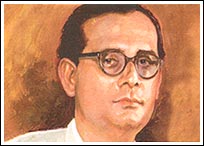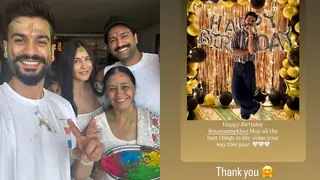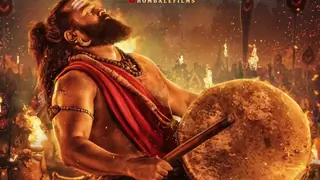The man with the golden voice
The Nameplate on the door leading to his flat still bears his name. In the puja pandals, microphones still play his songs. Cassette companies still bring out new cassettes with his label. It hardly seems like its been five years since his death. Everything remains the same, except we dont hear any new songs or see any live programmes featuring the man with the golden voice, Hemanta Mukherjee. As his wife Bela Mukherjee tells us, Everything is going on. I am talking to you, eating when I feel hungry ... walking ... carrying on with my life ... but there is a huge void ... a feeling of emptiness. A loneliness which is unbearable. Born in 1920 in Benaras, Hemanta had quite an eventful childhood. His adolescence and youth also had their lively moments. As a little child Hemanta lived in a nondescript village called Baharu in Jainagar. It was in here that he developed a liking for music, thanks to his exposure to jatras and kabigaans . But soon he and his family shifted base to Calcutta where he enrolled in Nasiruddin Memorial High School and then in Golam Mitra Institution. It was in this school that he met the poet, Subhash Mukhopadhyay, who went on to become his best friend. He developed a keen interest in literature and got together with Mukhopadhyay and a few other friends to form Kalyan Sangha, a literary club which started a handwritten little magazine. Impromptu musical functions in the classroom, with Hemanta as the sole singer-cum-musician (desks being the only instrument) during tiffin breaks, became a regular affair. A singing star was born. In 1934, at the tender age of 14, Hemanta stepped into the sanctum sanctorum of musicians in those days - All India Radio. It was Subhash Mukhopadhyay who was instrumental in introducing Hemanta to AIR. Amar gaanete elo nabarupe chirontoni ... (penned by Mukhopadhyay and set to music by Kamal Dasgupta) was the song with which he began his innings. Needless to say, the youngster was very happy with his efforts, as was his mother. But his father was none too pleased because, like all fathers, he wanted his son to become an engineer. He never for a moment believed that a successful career in singing was at all possible. So it was thanks to his mother that Hemanta could continue with his singing.
The year 1937 was an eventful one for Hemanta. He passed his matriculation examination with a first division. His story was published in the esteemed vernacular magazine Desh and he cut his first disc with Columbia Records. This time his music director was Sailesh Datta Gupta and the lyricist Naresh Bhattacharya. This album proved to be quite a godsend because it made his voice familiar with the public. Hemanta was slowly but steadily getting fully involved in singing. Nevertheless, with his fathers cherished wishes in mind, he did enrol in the engineering course at Jadavpur University. But it became impossible to carry on with academics and music at the same time. The choice had to be made and Hemanta chose to pursue a career in singing. Meanwhile, to support himself, he decided to learn stenography on a part-time basis. Of course, his interest in it was also short-lived. By the end of 1938, Hemanta had left everything and taken up singing as a full-time profession - once again, against his fathers wishes. His mother was overjoyed and wrote in her diary, That day is not far when Hemantas record will be kept on the shelves of music shops beside those of Pankaj Mallik and Sachin Dev Burman - such was her optimism. To support himself and give his share to the family, he started giving tuitions. The road to success was a long and hard one and Hemanta had just started. Sometime during this period, he came to know music director Hariprasanna Das, who went on to become his mentor. Says Bela, It was Hariprasanna Das who gave him his first break and his first book of notations of Rabindrasangeet. It was from Rabindrasangeet that Hemanta used to get inspiration for whatever he did. Though later on Hemanta went on to become a great exponent of this art, he had no formal training in music. In fact, his initiation into Rabindrasangeet was quite accidental. In his own words, I used to visit Sailesh Datta Gupta regularly. There, he asked me one day if I knew Rabi Thakurs songs (that was what Rabindrasangeet was called in those days.) I answered in the negative, hearing which he gave me a book which had the notations of Aamar mallika boney... I learnt the song then and there. That was the first time I learnt a Rabindrasangeet. After that here was no looking back and Hemanta Mukherjee and Rabindrasangeet became an inseparable duo. He brushed up on his technique by taking lessons from Suchitra Mitra and tuning in to Pankaj Malliks Rabindrasangeet classes on All India Radio. Hemanta, to his credit, developed his own style of singing and, fortunately for him, it went down very well with the masses. This was possible, probably because he was not a typical Shantiniketani, as Vishwa-Bharati graduates are referred to as. And this also was precisely the point on which the critics harped the most while directing their barbs against Hemanta. He was also responsible for making Rabindrasangeet in integral part of Bengali film music. Even as late as the Eighties, he used it in films like Dadar Kirti and Bhalobasha Bhalobasha. Charana dharitey ... which was used in Dadar Kirti became particularly popular. It would not be an overstatement to say that Hemanta had a big hand in taking Rabindrasangeet to the masses. It was during his stint in AIR that he met Bela Mukherjee. Soon they were deeply in love with each other. As he wrote in his autobiography, I loved her very much but it was nothing romantic. Whatever romance took place was afterwards. The eventually got married in 1945. Before that, some significant events took place in Hemantas career. In 1940, he sang in films (Nemai Sanyasi) for the first time. Before that, he had also worked as an assistant to music director Hariprasanna Das in a film called Byabadhan . That was probably his first step towards music direction. Hemanta also had the opportunity to meet Tagore in Santiniketan in 1940 - a dream come true for him. He also Joined IPTA and became increasingly involved in its functioning. It was also around this time that he came to know music director Salil Chowdhury. However his association with IPTA did not last for too long. There was a time when he devoted himself entirely to IPTA. It was like another dream for him but he never wanted to get into the politics of the place. Many people, who were associated with it at that time, went on to make it big in politics. Anyway, it was this factor which disturbed him very much... it did not turn out the way he thought it would. So he left it, related Bela Mukherjee. If it was according to his dreams, his thoughts, he would never have left IPTA. He really loved that organisation too much. However, it wasnt as if nothing good came out of his stint with IPTA - the enduring partnership of Salil Chowdhury and Hemanta Mukherjee was born. In 1947, they cut their fist disc, Gaayer Badhu . This happened quite suddenly. Thanks to his stint at AIR, Hemanta had become quite a household name. One day, Salil Chowdhury visited him and asked Hemanta to listen to some of his music. All the songs were very much in keeping with Chowdhurys IPTA background-they were hard-hitting, progressive and had a strong, rhythmic beat. Though Hemanta liked these songs, he wanted to go for softer, more romantic numbers, something that the public lapped up. Chowdhury had to leave, disappointed and crestfallen. But only to return - with Kono ek gaayer badhu... which was an instant hit with Hemanta who found a lot of possibilities in the song. The second part of the song was written and the two parts were recorded immediately. The record became a bestseller. It caught every music-lovers attention. The lyrics were totally different from what was being written at that time. And above all Hemantas rendering was exemplary. In fact, the entire range of Bengali modern songs they went on to do together became superhits. Runner, Paalkir gaan, Aamay prashan karey, Dhitang dhitang boley, Thikana.. . all these songs carved themselves into the psyche of Bengal. It seemed like Salil Chowdhurys tunes were tailor-made for Hemantas voice and style of singing and vice-versa. That, in spite of the fact that the duo did not agree with each other on a very important point - orchestration. While Salil Chowdhury liked a 40-piece orchestra with big interludes and innovative sound effects, Mukherjee preferred recording with minimum music and the simplest of orchestrations. This, at times, led to a lot of tension between them, to the extent that once Hemanta recorded Chowdhurys song without informing him. His stand was that if he had informed Chowdhury he would have taken months to arrange the music, balance the orchestra and finally record it to his satisfaction. And no doubt infuriated Salil Chowdhury-but in all fairness, Chowdhury was also to blame in certain instances. As Hemanta would regret now and then, There are many Bengali songs of Salil which Ive sung and were superhits. But when he made Hindi songs from the same tunes, he seldom used me. Take Aamay prashna karey - when he used this tune in Anand (Kahin door jab din) , he chose Mukesh. This hurt me very much. Barring these minor misunderstandings, they shared an excellent relationship on both personal and the professional fronts. And the songs they produced were nothing less than masterpieces. Hemanta became a full-fledged music director in 1945 when he scored the music for two films, Purbaraag and Abhijaatri . This was just before be got married to Bela Mukherjee. She shyly adds, All the songs in Purbaraag were very good. I sang many songs in it ... in fact, all the songs for the heroine were rendered by me. After this, Hemanta started getting many offers but the sort of success and fame he deserved was still not coming his way. Whatever had happened to S. D. Burman was happening to him. It was only after he was successful in Bombay that Hemanta get the sort of recognition he deserved. In 1949, the legendary V. Shantaram called him to Bombay to do the music for a Bengali film he was planning. Though the film (Shiv Shakti) did not materialise it gave Hemantas career a fillip. He had already sung in the Hindi film Zameen Asmaan and on top of that he had been summoned by a filmmaker of Shantarams calibre. People who mattered in Tollywood started enquiring about a six-feet-plus fellow by the name of Hemanta Mukherjee. According to many, this was the turning point in Hemantas career. Others believe that mega-hit Nagin was the juncture. But his better-half points out, The turning point in his career had taken place much before that. It happened when he quit his engineering course to take a plunge into the world of music. He started doing tuitions to help out his father financially. This was the turning point. That financial crunch gave him the killer instinct. Hemanta left Calcutta and went to Bombay in 1952, Hemen Gupta being the person responsible for the turn of events. The film in question was Anandamath . Though we became quite settled in Bombay his mind would always be here in Calcutta. Every now and then he would search for a pretext to visit Calcutta, adds Bela Mukherjee. On top of that, live functions were not held in Bombay as frequently as they were in Calcutta. And everyone knows just how much he loved participating in soirees. The satisfaction, the encouragement he used to get from live programmes, he never got from films. This was one of the prime reasons for us returning to Calcutta. Talking of functions, a close associate of Hemanta Mukherjee reveals a very interesting incident. Hemantada had a sore throat that day and his voice was just not reaching the scale he normally sang in. He knew very well that the songs would never have the desired effect if he sang them at a lower scale. He continues, Hemantada went on stage and announced that the audience should not listen to his first four songs. Everybody was surprised. What was he up to? What he did was, he sang the first song two scales below his normal scale, the next one a bit higher and so on. When the fourth song was over and he started the fifth song. To everyones surprise, he had reached his normal scale ! After coming back to Calcutta, there was no looking back. He was talented, had a rich voice and what mattered most to producers, he was successful in Bombay. All the films he did bore his distinctive stamp, be it Deep Jwele Jai, Neel Aakasher Neechey or Shapmochan . The songs would have a very simple yet catchy tune, the orchestration would be minimum and the rendering would be straight from the heart. As his wife explains, He composed tunes which everybody could sing, for which one did not require any formal training. This was misinterpreted by many people. They said that since Hemanta did not have the necessary classical base, he shirked away from the more difficult tunes. Hemantas reply to such allegations would be, Yes, its true I dont have any classical base. It is also true that I cannot sing like Lata but that is not the reason behind my simple tunes. I do so because I want to reach the common people. In fact, the once went to the extent of saying, I doubt whether I could have retained my voice if I had learned classical music. Hemantas style of composing was quite simple, but it was totally dependent on his mood. Says Bela Mukherjee, When he would be in a good mood it would hardly take him five minutes to compose one entire song but if the mood was not right, even five days would not be sufficient. She remembers a particular incident when he composed two songs, one after the other, while travelling in a bus. This was also applicable when he sang under somebody elses direction. I remember a particular incident in which he was called by Robin Chatterjee. He taught him two songs and seeing that he had a very good voice on that particular day, recorded the two songs then and there. A very memorable part of Hemantas career was his innumerable foreign tours. Wherever he went, he received a heros welcome. His wife recalls, fondly: It was probably in the West Indies. He had a function and it was a sellout. There were thousands of people waiting outside just to hear and see him. He was so moved that on seeing this, he requested the organisers to open the gates. When they declined, he told them, If you want, Ill do the function free of cost, but please let them in. Finally the gates were opened. In another incident, which took place in Surinaam, they were once again left pleasantly surprised by the warmth of the people. Our plane was about to land when we saw the runway was swarming with humanity ... thousands of them. We thought that some VIP was aboard and started looking for them in our plane. When we couldnt find anyone, we still never imagined that they were actually waiting for him. We though that may be there was some VIP whom we did not know. But when the plane landed... it was unbelievable.. people were fighting among themselves just to touch him.. to see him. We were really touched. But this ever-popular singer would never have become a singer if writer Premendra Mitra had had his way. Consider this event : when Hemanta was in his teens Mitra had once taken him to a film-maker for a screen test. Though he had all the qualities of a good hero, he failed the test. Thank God for that ! Hemanta suffered his first heart attack in 1983. In 1985, he was awarded a D.Litt. by Vishwa-Bharati; 1987 saw him winning the National Award (for Lalan Fakir ) and the Sangeet Natak Akademi award. But after so many awards, when he was offered the Padma Shree he refused - twice. His assistants got it much before, people much junior to him got it before. Would it have been right for him to accept the award? If the government sincerely wanted to show its appreciation, they should have given the highest award and not the Padma Shree, Bela Mukherjee says angrily. However, before the government could take any steps to honour the singer, he passed away on the September 26, 1989. Some poets have been known to have written their own epitaphs. As for Hemanta he had sung his epitaph long before be passed away : Aamar ganer swaralipi lekha rabey...
Written by: Saurav Chakravarti



























